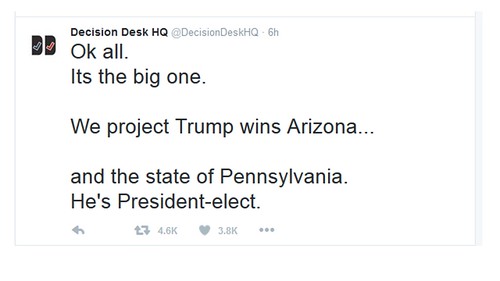President-Elect Trump

1 am Tweet from Decision Desk HQ, announcing Trump Presidency
At 10 p.m. last night, Twitter reported that the Canadian immigration website had crashed. It was time to go to bed. While the election outcome wasn’t final, by that point it was clear to me that Donald Trump would be the next president of the United States. I did go to bed, but I confess to not sleeping very well.
During the 2012 presidential campaign, Nate Silver, the data guru of the New York Times, seemed to provide the best data analysis of what was going to happen and what did happen. Shortly after that, Silver left the Times to start his own site called FiveThirtyEight. I continued to follow Silver and, as this election drew near, paid close attention to his daily emails.
As yesterday’s election drew near. Silver, who interprets polls taken by others instead of doing his own polling, wrote that aggregating all national polls gave Clinton a 3 percent lead in the popular vote and similar leads in state polls. But he only gave Clinton a 67 percent chance of victory while similar websites were rating her chances in the 90 percent range. Silver explained that it was not uncommon for polls to be off by up to 3 percent. That was the case in 2012 when the polls gave Obama a 3 percent lead over Romney, but Obama won by 6 percent. (Because the error was in Obama’s favor, perhaps some of us were less likely to notice it). Silver said that a 3 percent error in the 2016 polls could end up as a Clinton landslide or, if the error was in the other direction, a very close race popular-vote wise, but also one that opened a clear path to a Trump victory in the Electoral College. Silver further explained that Clinton could take little comfort in state polls, because they did not exist in isolation. An error in one state poll would likely bleed across state boundaries and affect them all.
With that in mind last night, I shifted from covering the Lowell City Council meeting (which ended at 7:12 pm) to following election results on Twitter and the New York Times website. (When the council meeting ended, I spun my TV dial to some of the traditional news channels but quickly found them more annoying than informative and so pulled the plug on television for the night).
At first, things went predictably. Indiana and Kentucky were called for Trump at 7 pm, the same time Vermont went for Clinton. At 8, Massachusetts and Maryland offset Tennessee and Oklahoma. Florida was a key early indicator. Clinton could win without Florida, but Trump could not. In my mind, an early and healthy lead in Florida for Clinton would point to a solid Democratic victory. But Florida was too close to call; so was North Carolina; so was Virginia. As the votes were counted, the trends in Florida and North Carolina were towards Trump. When early returns from Ohio, Pennsylvania, Wisconsin, and Michigan all showed surprising strength for Trump, it was pretty clear that Nate Silver’s 3 point polling error had happened and it had happened in Trump’s favor. That’s when I headed to bed.
Awake at 1 am, I reached for my phone and opened Twitter just in time for “Decision Desk HQ” to tweet, “OK all. It’s the big one. We project Trump wins Arizona … and the state of Pennsylvania. He’s President-elect.”
Sorting out what happened and why will take some time. The electorate wasn’t just divided, it was VERY divided, so today people will either be euphoric or distraught. With the strong performance of its Senate candidates across the country – who knew Trump would have such long coattails? – the Republican Party will control the presidency, both houses of Congress, and the Supreme Court (just as soon as they confirm whoever Trump nominates to fill the seat vacant since Justice Scalia’s death).
If you like what happened, Congratulations. If you don’t like it, remember that all politics is local. The American political system is very fluid and is filled with moving parts. In the past, whether it was during the tenure of Ronald Reagan or of Barrack Obama, whichever party was out of power at the federal level turned to state and local government to effect change. I expect the same thing will happen this time, which makes the people we elect to represent us at the Massachusetts State House and at Lowell City Hall all the more important.
With that in mind, let’s take a quick look at the contested local races decided last night. Niki Tsongas defeated Ann Wofford by 38 points, 69 percent to 31 percent (in Lowell, Tsongas received 27,889 votes to 6,805 for Wofford, an 80 percent to 20 percent margin). In the 18th Middlesex District state representative race, Rady Mom defeated Kamara Kay by 44 points, 72 percent to 28 percent (7,985 to 3,091 votes). And Clinton won Lowell, getting 23,186 votes to 10,495 votes for Trump (65 percent to 30 percent).
As for the ballot questions statewide, Question 1 (expand slot machine gaming) lost 61 percent to 39 percent; Question 2 (more charter schools) lost 62 percent to 38 percent; Question 3 (better treatment of farm animals) won 78 percent to 22 percent; and Question 4 (legalization of marijuana) won 54 percent to 46 percent.
In Lowell, the ballot question results were: On slots, 52 percent yes, 48 percent no; on charter schools, 57 percent no, 43 percent yes; on farm animals, 77 percent yes, 23 percent no; and on marijuana, 56 percent yes, 44 percent no.
Based on the Question 4 result, recreational use of marijuana will be legal in Massachusetts by mid-December which may offer some comfort to those who envision difficulties dealing with a Trump Presidency.